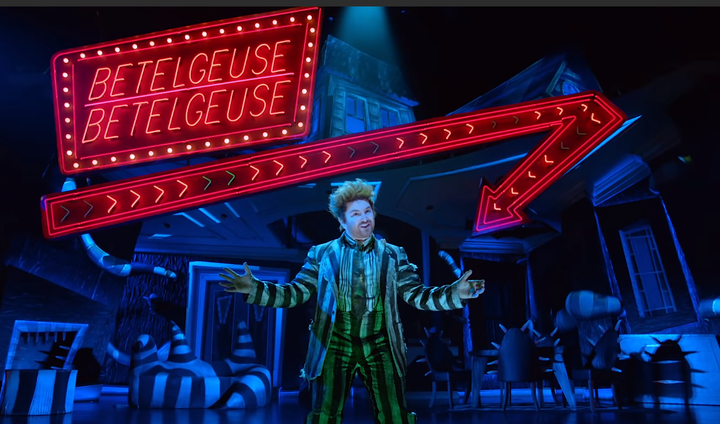The Hamilton Set
Musical sets are unique because they must be both practical and symbolic. The set of Hamilton excels in both aspects.
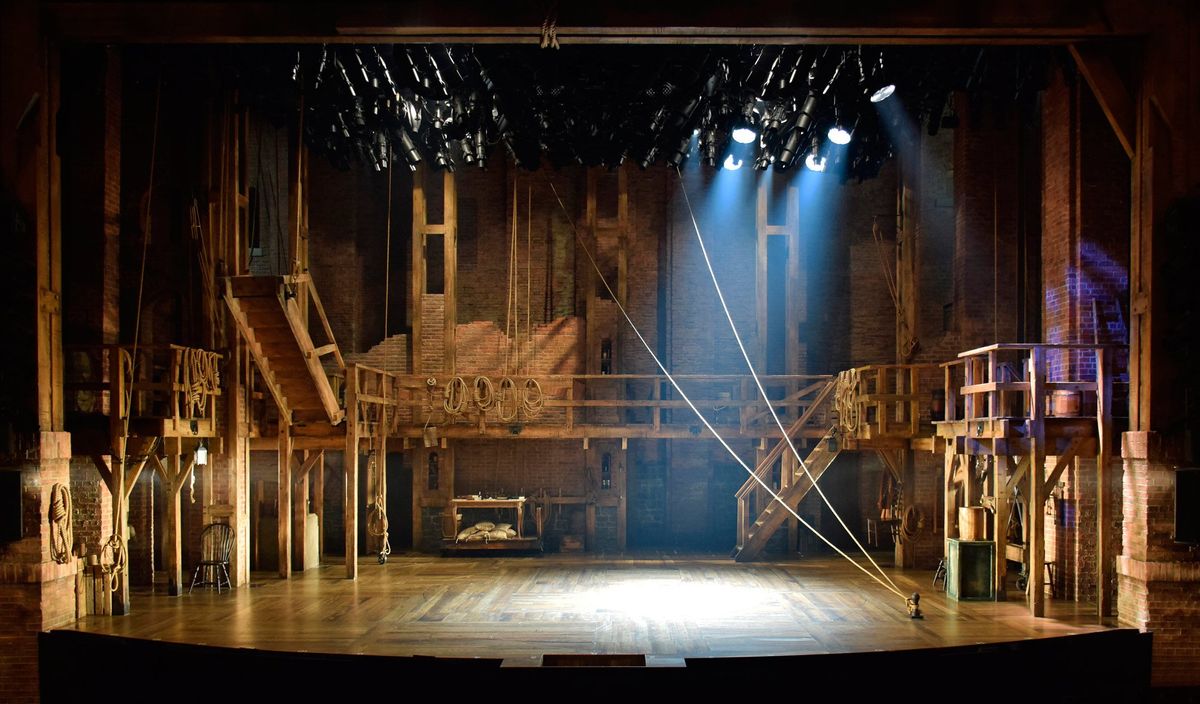
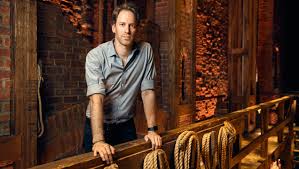
We all know the musical Hamilton, written by Lin-Manuel Miranda. However, the importance of the set designed by David Korins is often underestimated. When one thinks of a theatre performance, they remember the actors, songs, and drama. However, none of those are possible without a well-crafted and symbolic set. Hamilton is no different. Musical sets are unique because they must be both practical and symbolic. The set of Hamilton excels in both aspects.
Practical Set Design:
The set of Hamilton is not a traditional set. There are no wagons, flats, or scenes. It is a single backdrop with minimal moving parts. Each part of the set has a very specific purpose, and no space is wasted. Practically, the Hamilton set is a masterpiece. It was designed because there are far too many locations in the musical to create a traditional set. There are 50 songs, over 20,000 words and the musical spans about 30 years. The sheer number of set changes that would be needed is impossible to create and practically use in a single performance. This is, while the set does have some moving parts (the stairwell, the turntable, and the props) it is mainly stationary and highly symbolic. The set is not trying to invoke a sense of place or create scenery.
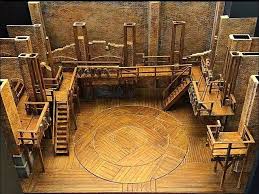
The set is mainly brick and wooden scaffolding. It is augmented with ropes and minimal props. It was designed for easy set up and travel. In addition, there are nooks and cubbies hidden all throughout the set. These helps facilitate access to props and quick transitions between scenes.
When viewing the musical in the theatre, the set is complex and interesting. However, the version of the musical on Disney+ does not do the set justice. The camera never focuses on any part of the set long enough for examination. The grandeur of the set is obvious in theatre; however, the video version mainly uses close-ups on the characters rather than wide shots that would do the set justice. In addition, very carefully selected props are placed around the set to add to symbolism. These actually change between acts. Details are vital to the set, but they are all lost to the camera.
Symbolic Set Design:
The Hamilton set references two different colonial era sites. The first is a construction site. The brick wall and wooden scaffolding brings buildings in progress to mind. This symbolizes building the framework of a country. The foundations, brick in the set and laws, systems, and government in a country, are a vital part of any design. The second site is less a place and more a theme: nautical. This idea plays into many of the details of the set design and the reality of the time period (the majority of carpenters were ship builders) The corners on the scaffolding are all lap joints which were used in the construction of ships at the time. There are also ropes and pulleys scattered across the set. The nautical theme references immigration via boat (which is how Hamilton got to the 13 colonies) and also the importance of ships in the war. Even Hamilton’s grand entrance in the beginning of the play is meant to symbolize disembarking from a ship.
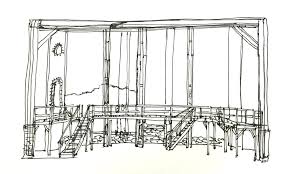
The set also changes between acts to symbolize the change in themes. In the first act the props on stage are guns, buckets, and other references to the war. However, in the second act there are a few subtle changes to the set. First, the brick walls ascend eight feet. This symbolizes how the foundation of the country is growing larger and stronger. Also, the props change from rifles to maps, books, and quills. This reinforces that the war is over, and it is now time to govern.
A couple props and set features are far more important than the others: the desk and the double turn table. While all of the props were carefully selected and placed, these two hold the most practicality and symbolism.
The desk:
The desk used in the musical is an accurate reproduction of Alexander Hamilton’s real desk. Korins came across it during his research, which took him to countless historical sites including Hamilton’s home, Mount Vernon, and many of the battlefields of the war. The desk is on a rolling cart for quick and easy movement. It is also fortified for practicality and durability. The props on and around the desk change between the acts of the play. In the beginning, there are sacks the represent Hamilton trading goods in the Caribbean. As he moves away from that life, the sacks disappear and an increasing amount of paper and writing utensils appear.
Double turn table:
The double turn table is one of the most unique and recognizable part of the Hamilton set. It is made up of two moving rings and a small, stationary center circle. It is used in many of the numbers to represent movement in space and time. The turntable was inspired by storms: hurricanes, political storms, and scandals. These events are reoccurring in Hamilton’s life and in the musical. It also symbolizes the relationship between Hamilton and Burr. They are always circling around each other, in their careers, politics, and even social lives. They have a cyclical relationship. And their rivalry slowly spirals out of control.
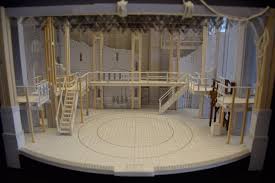
The double turn table is used in many of the numbers both for practicality and symbolism. In the “Schuyler Sisters,” it is used in one of its most basic and least symbolic ways. It spins to create the show the sisters walking across town. However, as the play progresses, the turn table is used in an increasingly symbolic manner. In “Satisfied” it is used to turn back and move forward time. It is used in “The World Was Wide Enough” and “Blow Us All Away” the turntable is used to slow down and speed up time after the characters are shot. In “The Ten Dual Commandments” the turn table is used to create drama and movement during the duel. “Hurricane” is one of the most symbolic uses of the double turn table. Literally, to allows props and people to move around him like a hurricane. But it also, shows Hamilton’s life events swirling around him. His life is a whirlwind, chaos and it is quickly spiraling out of his control.
“[The double turn table] was inspired by cyclical relationship between Aaron Burr and Hamilton, where they were basically spiraling around each other their entire careers and lives.” David Korins
In the end, a successful musical is made of more than one factor. Details are vital, symbolism must be everywhere, and practicality needs to be taken into account. The set of Hamilton, created by David Korins, is a perfect blend of all the factors that make a set a masterpiece. It does not just provide a backdrop to the musical but is an intrinsic part of the musical. Like the musical, the Hamilton set is a monument to theatre.
If you want to know more about Korins and what he has to say about the Hamilton set here are some more resources.
- Korins talking about the set design (video on Instagram)
- Rachel Wallace: "Hamilton Designer David Korins Reflects on the Juggernaut Play"
- Roger Catlin: "Hamilton’s David Korins Explains What Makes the Smash Hit’s Design So Versatile"
- Patricia Sullivan: "Designer David Korins reveals the inspiration, details, and big ideas behind his set for the Broadway production of Hamilton"
